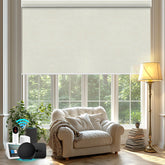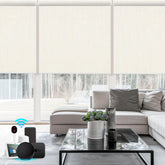Light Filtering vs Blackout Shades
When deciding on window treatments, most homeowners are faced with a single, essential question: light filtering or blackout shades?
At first glance, it seems like a simple style choice, but the decision can affect comfort, utility bills, sleep quality, and even daily mood.
Here, we will clarify light filtering and blackout shades, explaining how each operates, what distinguishes them, and how to choose the option that best matches your lifestyle.

What Are Light Filtering Shades?
Light filtering shades consist of semi-opaque materials designed to diffuse sunlight. They admit daylight while significantly reducing glare.
You will find light filtering roller shades in various styles and fabrics. The intent is to wash a room in soft, even light, fostering a serene environment that lessens reliance on ceiling fixtures.
Some blackout shades have secured their place in contemporary homes by balancing everyday usefulness with a minimalist look.
Homeowners are more aware of fading than ever, so the newest treatments feature UV-blocking technologies that protect upholstery, hardwoods, and cherished artwork from relentless sunlight.
What Are Blackout Shades?
So, what are blackout shades, precisely? They are crafted to eliminate any light leakage when fully lowered.
The textile is woven so tightly and treated so thoroughly that sunlight is prevented from penetrating the front and escaping along the edges.
Suppliers plan to sharpen the edges, introduce a pair of insulating air cavities, and layer in sound-deadening materials to create quieter, more restful spaces.
These blackout roller shades benefit anyone who battles bright weekday sun, night-shifters needing daytime sleep, or anyone who prefers total darkness.
They are equally essential in dedicated home theaters and gaming rooms, eliminating glare to guarantee a perfect picture and the deepest blacks.
Key Differences Between Light Filtering and Blackout Shades
| Feature | Light Filtering Shades | Blackout Shades |
| Light Control | Softens natural light | Blocks out all light |
| Privacy | Partial | Complete |
| Ideal Use | Living rooms, kitchens | Bedrooms, home theaters |
| Energy Efficiency | Moderate | High (better insulation) |
| Aesthetic | Light and airy | Sleek and dark |
| Cost | Moderate | Slightly higher |
Light-filtering shades allow a mellow, inviting radiance through the day; blackout shades create total stillness.
The variations affect mood and microclimate, plus the overall edge for your energy bill and the feel of your space.
Where to Use Light Filtering Shades

Install these shades wherever you welcome sunlight but don’t need total blackout.
- Living rooms: Infuse the space with soft, golden light
- Home offices: Soften screen glare and keep the environment open
- Dining rooms: Create a warm, bright atmosphere
- Kitchens: Diffuse harsh noon light while keeping visibility
In two- or three-story homes or in rooms far from the street, the shades grant needed privacy while bathing the interior in an even, gentle radiance.
Where to Use Blackout Shades

Blackout shades belong in rooms where complete darkness or absolute concealment is the priority.
- Bedrooms: Sleep more soundly by dimming street lamps and blocking the early dawn.
- Nurseries: Help tiny eyes drift and stay asleep, day or night.
- Media rooms: Protect the screen by guarding it against any stray glow.
- Guest rooms: Create the hush and comfort of a peaceful retreat.
In city flats or any room facing a busy street, blackout roller shades hush the glare and the rumble of traffic.
Benefits of Light Filtering Shades
- Gentle Glow: Delivers soft, even light that’s kind to the eyes.
- UV Guard: Protects fabrics and wood from fading summer rays.
- Energy Boost: Floods the room with daylight, so lamps stay off.
- Choice Abundance: Comes in almost limitless weaves, colors, and textures.
- Privacy Dial: Blurs the street view while keeping the room bright.
New models have a reflective back that bounces summer heat away, letting cool daylight fill the room.
Benefits of Blackout Shades
Perfect for anyone who craves solid sleep, for night owls, or for toddlers whose naps should never be interrupted.
- Quiet Spaces: Advanced acoustic fibers now woven into these shades soak up sound, turning rooms into havens.
- Energy Savers: A built-in thermal barrier keeps temps steady, so the HVAC takes a breather.
- Full Concealment: No glow or shadow escapes, even when the rest of the house sparkles.
- Chic Look: Clean, trim profiles slide into any modern room without a hitch.
With wellness now a top priority, these shades deliver calm, quiet, and cool, all in one stylish package.
Room-by-Room Shade Guide: Light Filtering vs Blackout
| Room | Recommended Shade Type | Why |
| Living Room | Light Filtering | Soft light, daytime comfort |
| Bedroom | Blackout | Improves sleep, ensures privacy |
| Kitchen | Light Filtering | Bright, clean look with UV control |
| Nursery | Blackout | Dark space supports a sleep routine |
| Home Office | Light Filtering | Reduces screen glare, natural light |
| Media Room | Blackout | No reflections or ambient light |
Each room asks for its own light and privacy recipe. This roadmap hands you the perfect shade for the job.
Privacy at Night: Which Shade Wins?
Light filtering shades protect you during the day. At night, when the inside lights blaze, they fall short. Blackout shades stand ready, guarding your space from outside eyes, 24/7.
When you have got the overhead lights blazing, anyone passing by can peer right in, even through the thinnest sheers or open-weave panels.
Shut that glare down with blackout shades, and you claim the top spot for keeping the room private.
Blackout shades promise complete privacy whenever you like. They shine in street-level bedrooms, lofty urban spaces, or any room where someone walking by can see straight in.
If you won’t compromise on a calm, dark sanctuary when night falls, blackout is your answer.
Energy Efficiency: Which Shade Saves More?

Cutting energy waste is top of mind for all of us this year. Both types of shades ease heating and cooling costs, but blackout shades pull ahead.
- Light-filtering shades: They soften harsh sun, lower glare, and let in a little welcomed warmth from the sun.
- Blackout shades: They block heat exchange more completely, keeping conditioned air where you want it.
Today’s blackout options come with reflective backings and honeycomb layers that hold air; by trapping energy, they trim utility costs and suit the careful spender.
Health and Wellness: How Your Shades Affect Daily Life
Light levels inside your home can sway sleep, mood, and productivity more than many people notice.
- Blackout shades: They help you drift off more quickly and stay in deep sleep longer, keeping melatonin flowing.
- Light-filtering shades: They greet the morning sun, helping reset your internal clock and lifting alertness.
Designs that center on wellness will be everywhere. The shade you pick can quietly support your daily rhythm and your longer health ambitions.
Aesthetic and Design Options of Light Filtering vs. Blackout Shades
The new window shades should feel like they’ve always belonged in your space. This year, the choices feel endless:
- Light-filtering styles: handwoven grasses, airy sheers, and soft, muted linens come together in calm, breathable colors.
- Blackout designs: Jewel tones, rich layered textures, and minimalist metallics create a drama that goes dark when you want.
Both collections offer cordless and motorized lifts, along with the versatile top-down/bottom-up option, so beauty and safety for kids and pets coexist effortlessly.
Smart Home Integration for Window Shades

Contemporary shades do more than dress the window:
- Voice commands: Connect effortlessly to Alexa, Google Assistant, or Siri for instant access.
- Automated routines: Teach them to greet the dawn and hush for bedtime on their own.
- Intelligent sensors: They sense the sunlight’s shift or a rise in room temperature and respond without a finger lifted.
For the ultimate in flexibility, many brands pair light-filtering and full-blackout fabrics in a dual-layer design, adjusted with a remote or an app.
Light Filtering vs Blackout Shades for Renters
Renters want beauty that’s temporary and kind to walls. The best solutions require no drill blinds:
- Tension rod shades: they sit gently in the window frame and compress to a perfect fit.
- Peel-and-stick blackout panels: press them on in seconds, and peel them off cleanly when it’s time to move.
- Clip-on cellular shades attach with Velcro and tuck away in a pocket the size of a book, ready to transform any room.
Choose airy light-filtering fabric for a sun-dappled glow or the newest blackout option that collapses flat and slips off in seconds, keeping the look tidy and your lease intact.
Final Thoughts: Finding Your Ideal Shade
There is no universal answer. The right hue fits your daily rhythm, the vibe of each room, and the style you want to express.
Choose light-filtering if you love a soft, diffused glow in bright, open areas or when you want to soften the sun’s glare.
Pick blackout when you want total darkness in a bedroom, work nights, or seek absolute seclusion.
Want a little of both? Go with dual-function shades or layer with curtains so you can adjust the light to suit your mood.
Modern shades can also be eco-conscious, visually striking, and high-tech—all of which can lift the look of any room. Read Window Treatment Trends: 2025 Guide to Window Blinds & Shades to explore more!




